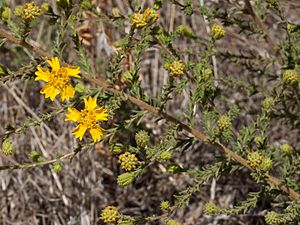Heermann's tarweed facts for kids
Quick facts for kids Heermann's tarweed |
|
|---|---|
 |
|
| Scientific classification | |
| Kingdom: | |
| (unranked): | |
| (unranked): | |
| (unranked): | |
| Order: | |
| Family: | |
| Genus: | |
| Species: |
H. heermannii
|
| Binomial name | |
| Holocarpha heermannii (Greene) D.D.Keck
|
|
| Synonyms | |
|
|
Holocarpha heermannii is a type of flowering plant often called Heermann's tarweed. It belongs to the aster family, which includes plants like sunflowers and daisies. This special plant grows only in California.
Contents
Where Heermann's Tarweed Grows
Heermann's tarweed is a plant that loves California. It grows in many different places there. You can find it in the hills, mountains, and valleys. It prefers the central and southern parts of the state.
This plant is very common in certain areas. These include the Inner Coast Ranges near the San Francisco Bay Area. It also thrives in the southern foothills of the Sierra Nevada. Another favorite spot is the Tehachapi Mountains. You might also see it in the Southern Outer California Coast Ranges. It grows in the western Transverse Ranges too.
What Heermann's Tarweed Looks Like
Heermann's tarweed is an annual herb. This means it grows from a seed, flowers, produces seeds, and dies all in one year. It usually grows straight up. It can be about 20 centimetres (7.9 in) tall, but some plants can grow over 1 metre (3.3 ft) high!
The stem of the plant is quite sticky. It has many small glands that produce a sticky resin. It is also covered in short and long hairs. The leaves near the bottom of the plant can be up to 10 centimetres (3.9 in) long. Leaves higher up on the stem are smaller.
Flowers and Their Structure
The plant's flowers grow in a wide, branching pattern. Each branch holds clusters of flower heads. A flower head looks like one large flower, but it's actually many tiny flowers grouped together.
Each flower head has special leaves called phyllaries around its base. These phyllaries are very sticky. They are covered in large, round glands that produce resin. They also have many hairs. Inside the head, you'll find many yellow disc florets. These are the small, tube-shaped flowers in the center. Around them are three to 10 golden yellow ray florets. These look like petals.
Seeds and Reproduction
After the flowers bloom, they produce seeds. These seeds are called achenes. The achenes from the ray florets and the fertile disc florets have different shapes. This helps the plant spread its seeds in various ways.

